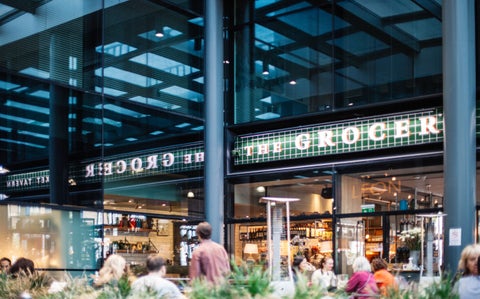Could Consignment Inventory Be Your CPG’s Secret Breakthrough Tool?
What’s been the biggest challenge since starting your CPG? Maybe you struggled with finding your brand voice or understanding Instagram’s algorithm (does anyone?).
But top of most CPG owners’ struggle-lists has to be getting stocked in the right retailers.
With so many brands attempting to get their products into stores — and retailers only having so much shelf space — it can often prove difficult for new or unproven names to get their foot in the door.
Could consignment inventory be the insider’s way to break through?
Working with consignment inventory can not only help get your products in front of your target market, boosting your brand awareness. But, when done right, it can also reduce your operating costs and make your supply chain more efficient.
Interested to hear more? We thought you might be...

What is consignment inventory?
In consignment inventory (CI), a manufacturer ships their products to a retailer and then retains legal ownership of them until they are sold to consumers or otherwise consumed within the business (damaged, misplaced, etc.).
As the consignor, you assume the majority of the risk, while the retailer, the consignee, can choose to return any unsold stock without suffering financially.
This represents a very different workflow compared to traditional inventory practices, where the retailer pays for the products, takes possession of them, and then recoups the costs when the products are sold.
This benefits retailers as it allows them to expand their product range, and test consumer demand, with little to no financial risk. But actually, consignment inventory can benefit everyone involved, as there can be a number of key advantages for the consignor, too.
What are the benefits of consignment inventory for CPG?
At first glance, consignment inventory seems to mostly favor retailers. But hold up: there are plenty of reasons for CPG businesses to turn to this way of working as well.
A quicker route to market for beginners
Consignment inventory is low-risk for the retailer and, as a result, you may just find it easier to get your first stockists using this approach.
We can’t promise anything, of course. But if you’re struggling to get initial retail agreements then CI might be the ticket to get in front of consumers and drum up some interest.
Lower costs
Inventory is inventory, wherever it’s being stored. But because you no longer have to house the consigned supply, you’re essentially transferring its storage costs over to the consignees.
Streamlined supply chain
Similarly, because you’re no longer storing the products yourself, you also don’t have to arrange for them to be transported to the warehouse and added to inventory. You can send them straight to retailers instead!
This reduces shipping times, as well as lowering your storage and labor costs. Great news!
Real-world customer feedback
CI allows you to test how well your products are received by consumers — that’s important for all CPGs, but it’s essential for those trying to break through.
And if you’re an established CPG trying to gain access to a new region or market, then trialing your products through CI is a fantastic way to dip your toe in the water without committing too many resources to the project.
In both scenarios, this could provide valuable customer insights for improving your products and honing your branding/marketing efforts.

What are the challenges of consignment inventory for CPG?
Nothing’s perfect, is it? So while there’s plenty of pros to consider about consignment inventory, it’s worth understanding the cons as well.
Your products might not sell
Let’s get the big one out of the way first: there’s always a risk that consumers won’t buy your product.
That’s an inherent risk of manufacturing and attempting to sell any product. But in the case of consignment inventory, your stock is tied up without you receiving any revenue from it up-front.
This means there’s an opportunity cost attached to consigned inventory: if it’s in the hands of one particular retailer, then it’s not available for sale elsewhere.
Limited visibility
Once you ship your products to consignees, you’ll have little to no visibility of what’s happening with your products; your information is limited to as much as the retailer is willing to share.
This means it’s possible to have no idea what the retailer is doing with your products! Are your products in a favorable position within the store? What merchandising tricks are they applying? Are employees able to answer customer queries about ingredients, benefits, and so on? You may have to do a little Secret Shopper research to find out...
Irregular cash flow
Consignee retailers are only obliged to pay you when they’ve sold your products which, as we’ve just mentioned, isn’t something you’ve got a vast amount of control over. This has an effect on your cash flow, too — not only are you unsure when your consignees will pay you but there’s also little way of knowing how much you’ll receive.
As you can’t rely on this CI income, you also can’t plan around it. Not ideal for a growing CPG.
Is consignment inventory right for you?
Consignment inventory can be mutually beneficial for producers and retailers of CPG. But for it to have the best chance of success, it needs to be rolled out under the right circumstances.
Firstly, a CI arrangement is a great move if you’re confident that your products will definitely sell — if you could only get more eyeballs on them. If that sounds like you, then shipping your products on consignment will help put that confidence to the test. At best, you’ll be proven right and now have the opportunity to take your brand to new heights. At worst, you’ll learn things about your product range you wouldn’t have come to know otherwise.
Secondly, consignment inventory has the greatest chance of working out if you have the right retail partnerships. As your products don't cost the consignee anything (aside from the space in their store), there’s less incentive for them to promote them. A good retail partner, however, will see the potential in your product range and how they stand to benefit from them selling well.
At Buffalo Market, we’re specialist distributors of mission-driven food and beverage. We care about the impact your CPG can have on the world, so we care about getting it in-store — and sold! — as well.
If you’re interested in discussing the pros and cons of consignment inventory as they relate to your brand, and how we can get your products in the right retailers, contact us today .

